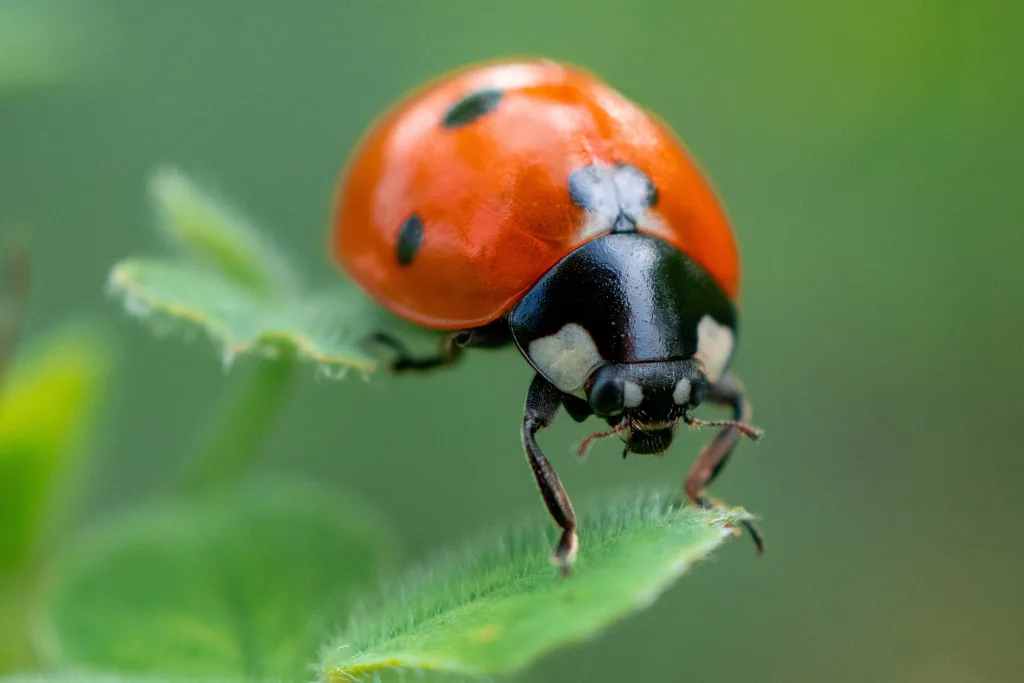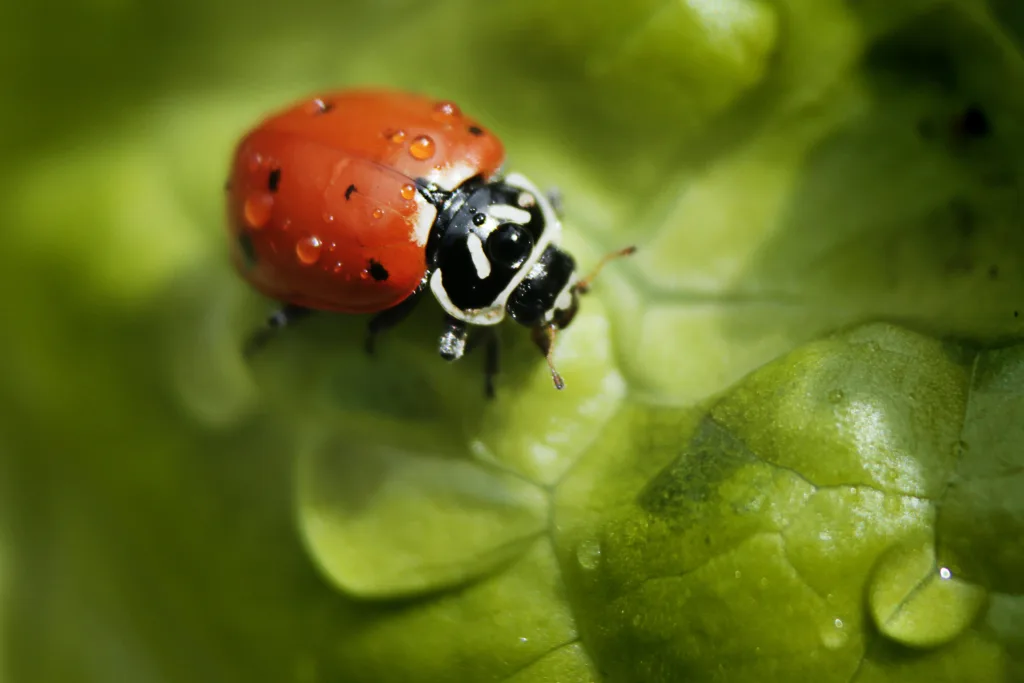Have you ever wondered if there are male ladybugs? Well, wonder no more! I’m here to tell you all about these little critters and their gender differences. So, let’s dive right in!
When you first lay eyes on a pair of ladybugs, it’s hard to tell them apart. They all seem to have those vibrant orange bodies with black spots. But if you take a closer look, you might notice a subtle difference in size. The male ladybug is slightly smaller than the female. Ah, the wonders of nature!
But size isn’t the only way to distinguish between the male and female ladybugs. You see, it’s only under a microscope that the true attributes of these little insects become visible. When examined closely, the male ladybug can be identified. And guess what? They are still called ladybugs! that’s right, the name encompasses both the male and female species of these adorable little creatures.
Now, you might be wondering how on earth can you determine the gender of a ladybug without a microscope? Well, my friend, it’s not an easy task. In fact, unless you are a specialist or have access to a powerful microscope, it’s nearly impossible to tell the difference. So, don’t fret if you can’t figure it out – even the experts have a hard time!
Contrary to popular belief, the number or size of black spots on the ladybug’s body has nothing to do with its gender. Both males and females sport these spots proudly. It’s all about what lies beneath the surface, hidden within their tiny bodies.
When it comes to mating, things get even more interesting. Male ladybugs have a unique way of courting their potential partners. During the mating process, the male grips onto the hard wings of the female, remaining on top of her for quite some time – up to two hours! Talk about dedication!
So, why are they still called ladybugs if they include both males and females? Well, it turns out that ladybugs go by many names. Ladybird, ladybird beetle, lady beetle, lady fly – you name it! But no matter what you call them, they aren’t all ladies. Plenty of ladybugs are actually males, adding a touch of irony to their already fascinating existence.
Determining the gender of a ladybug is no easy task. Without a microscope, it’s nearly impossible to tell them apart. But rest assured, both males and females exist in the world of ladybugs. So, next time you spot one of these charming creatures, remember that there’s more to them than meets the eye.
How Do You Know If A Ladybug Is A Boy Or A Girl?
Well, my friend, let me tell you all about these litte bug buddies! Now, when it comes to ladybugs, it can be pretty tricky to tell the boys from the girls. They don’t exactly come with little signs saying “I’m a boy” or “I’m a girl.” But fear not, my curious companion, for there are a few ways to distinguish between the male and female ladybugs.
First things first, size matters! When you spot a pair of ladybugs, take a closer look. The male ladybug is generally smaller than the female. So if you see a ladybug duo and one is noticeably tinier, chances are that’s the male bug.
But here’s where the real detective work begins. To truly confirm the gender, you’ll need to whip out a microscope and get up close and personal. Under the magnifying lens, the subtle differences in their attributes become visible.
Now, picture this – during the magical moment of ladybug romance, the male ladybug grips onto the hard wings of the female. Yep, he literally holds onto her wings for dear life! This gripping action helps them stay connected during the intimate act of mating. And let me tell you, my friend, these little guys can stay like this for up to two hours! Talk about stamina!
So, under the microscope, you’ll notice that the male ladybug has special gripping pads on its legs. These pads allow him to hold onto the female’s wings with a tight grasp. It’s like their version of holding hands, but a bit more…bug-like.
Now, I have to admit, this may not be the most glamorous or romantic way to determine ladybug gender, but hey, it’s nature’s way! And it’s pretty fascinating to witness these little insects going about their business.

What Do You Call A Male Ladybugs?
Well, let me tell you something fascinating about ladybugs! Did you know that both male and female ladybugs are actually called ladybugs? that’s right! The name “ladybug” encompasses both the male and female species of these adorable little insects. So, whether it’s a male or female ladybug, we simply refer to them as ladybugs.
Now, here’s the interesting part. Determining the gender of a ladybug can be quite a challenge unless you’re a specialist who looks at ladybugs under a microscope. They might have some subtle physical differences, but for most of us, it’s nearly impossible to tell them apart just by looking at them.
So, the next time you come across a ladybug, whether it’s red, orange, or even black with spots, just remember that the term “ladybug” covers both the males and females of this charming insect. It’s amazing how nature has a way of keeping things simple, isn’t it?
Are Orange Ladybugs Male?
The color of a ladybug does not determine its gender. Whether a ladybug is orange or any othr color, it can be either male or female. The determination of a ladybug’s gender is not based on its appearance, but rather on its reproductive organs.
To determine if a ladybug is male or female, we need to look at its physical characteristics. Generally, male ladybugs are slightly smaller in size compared to females. However, this difference in size may not always be noticeable.
The reproductive organs of a ladybug are located in the abdomen, along with its digestive and respiratory organs. These organs are not visible from the outside, so determining the gender of a ladybug by simply looking at its body is not possible.
If you’re really curious about the gender of a ladybug, you might need to observe its behavior during mating season. Male ladybugs are known to exhibit certain behaviors to attract females, such as releasing pheromones or engaging in courtship rituals. However, observing these behaviors can be quite challenging, as ladybugs are small and tend to move quickly.
Determining the gender of a ladybug cannot be done by looking at its color or the number of spots. It requires a closer examination of its physical characteristics or observing its behavior during mating season.
What Gender Are All Ladybugs?
Well, let me tell you something interesting about ladybugs! Contrary to what many people think, not all ladybugs are ladies. In fact, plenty of ladybugs are actually males. That’s right, these little bugs are not bound by gender stereotypes!
You see, ladybugs are a type of beetle that belong to the family Coccinellidae. And just like other beetles, ladybugs have both males and females. The reason they got their name “ladybugs” is because they were historically associated with the Virgin Mary, who was often depicted wearing a red cloak with black spots. So, people started calling them “lady” bugs, thinking that they were all females.
But the truth is, ladybugs come in both genders. The males and females of this species may look similar, with their characteristic round shape and vibrant colors. They typically have a red or orange body with black spots, though some species can have different patterns or colors.
Now, you might be wondering how to tell the difference between male and female ladybugs. Well, it can be a bit challenging because they don’t have any obvious external reproductive organs. However, there are some subtle differences that can help you distinguish between the two, if you look closely enough. For example, male ladybugs tend to be slightly smaller than females, and their spots might be more elongated or less defined.
But here’s the thing: unless you’re an expert or have a keen eye, it can be quite tricky to determine the gender of a ladybug just by looking at it. So, in most cases, it’s safe to say that ladybugs can be either male or female, just like many other creatures in the animal kingdom.
Isn’t it fascinating how nature surprises us sometimes? These little bugs, with their charming appearance, can teach us not to judge based on stereotypes. So, the next time you spot a ladybug, remember that it could be a “lady” or a “gentleman” bug, enjoying its life as part of nature’s diversity.

Conclusion
So, my fellow bug enthusiasts, after diving deep into the world of ladybugs, we have come to a fascinating conclusion. Contrary to what we may have thought, ladybugs are not all ladies. In fact, plenty of ladybugs are males! It seems these little creatures have fooled us all with their misleading name.
Determining the gender of a ladybug is no easy task, my friends. Unless you have a microscope handy and are a specialist in ladybug anatomy, it’s nearly impossible to distinguish between the males and females. They look almost identical to the naked eye, and those black spots on their vibrant orange bodies are shared by both sexes.
But fear not! There are a few clues that can help us in our quest to unveil the gender of these charming insects. The male ladybug tends to be slightly smaller than the female, so size can be a hint, albeit a subtle one. However, the surefire way to identify a male ladybug is by examining their intimate parts uner a microscope. my friends, things get up close and personal when it comes to ladybug gender identification!
During mating, the male ladybug takes on a rather dominant role, gripping the hard wings of the female and remaining on top of her for up to two hours. It’s quite a sight to behold, I must say. But don’t worry, folks, it’s all consensual in the world of ladybugs.
So, there you have it, my bug-loving friends. The world of ladybugs is filled with surprises. They may go by different names – ladybird, ladybird beetle, lady beetle, lady fly – but the truth remains the same: ladybugs are not just ladies, they are gentlemen as well. And they certainly know how to make their presence known, whether it be through their charming polka-dotted bodies or their intriguing mating rituals.
Next time you spot a ladybug, take a moment to appreciate the mystery that lies beneath its tiny, colorful exterior. Who knows, you may just catch a glimpse of a male ladybug in action, displaying his strength and determination as he clings onto his mate. It’s a bug’s life, my friends, and the ladybug is here to remind us that gender is not always as simple as it seems.
